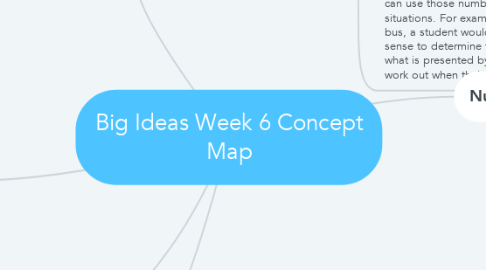
1. pascal's triangle
1.1. a triangular array of numbers in which those at the ends of the rows are 1 and each of the others is the sum of the nearest two numbers in the row above.
2. Mental computation
2.1. The act/ability to mentally analyse and work out sums. To do this, students need to, understand the concept behind operations and know basic number facts and strategies which help to process the information.
3. Numeration
3.1. The formal understanding of number and number notation, specifically related to naming, writing, reading, interpreting and processing numbers. In other words, it is the content and processes that are taught.
4. Number knowledge
4.1. consists of two main types. Those being formal, ideas related to numeration and place value, and those that are informal which is called number sense. Number sense essentially refers to a student's flexibility and fluidity with numbers. The student has sense of what numbers mean, understands their relationship to one another, is able to perform mental math, understands symbolic representations, and can use those numbers in real world situations. For example, when catching a bus, a student would use their number sense to determine the meaning behind what is presented by the time table to work out when their bus is coming.
5. Numbers
5.1. 3 types of numbers
5.1.1. ordinal numbers= tells the position of something i.e. 3rd, 4th, 5th etc.
5.1.2. cardinal numbers = says how many there are of something i.e. 1, 2, 3 etc.
5.1.3. nominal numbers = is a number used only as a name or to identify something i.e. postcode, 4074
5.2. prime and composite numbers
5.2.1. prime = numbers greater than 1 with only 2 different factors are PRIME.
5.2.2. composite = numbers greater than 1 with 3 or more different factors are COMPOSITE
5.3. shape numbers
5.3.1. A square number happens when a counting number is multiplied by itself i.e. 3x3= 9
5.3.2. Triangular numbers are obtained by adding the counting numbers from 1 e.g., 1; then 1+2; then 1+2+3; then 1+2+3+4
5.3.3. A cubic number relates to volume of a cube e.g., 3 x 3 x 3 = 27
5.4. odd and even numbers
5.4.1. An odd number is an integer which is not a multiple of two. If it is divided by two the result is a fraction.
5.4.2. An even number is an integer which is "evenly divisible" by two. This means that if the integer is divided by 2, it yields no remainder.
5.5. other numbers
5.5.1. Exponent = the number of times the ‘root’ or ‘base’ number is multiplied by itself e.g., 32 = 3 x 3 [base is 3, exponent is 2]
5.5.2. Integers = positive or negative whole numbers including 0 [usually represented on a number line]
5.5.3. Real Numbers = all rational and irrational numbers that can be placed on a number line [opposite of imaginary numbers which can’t be placed on a number line e.g., the square root of a negative number cannot be calculated, it is imaginary]

